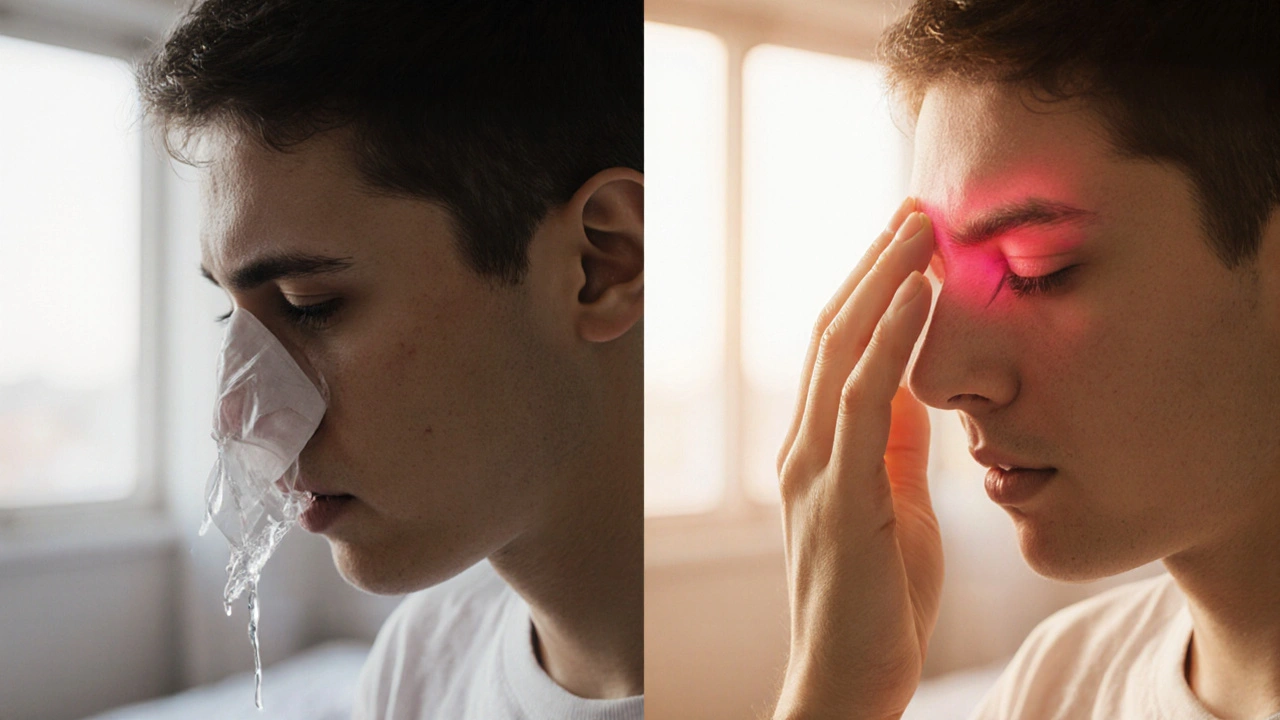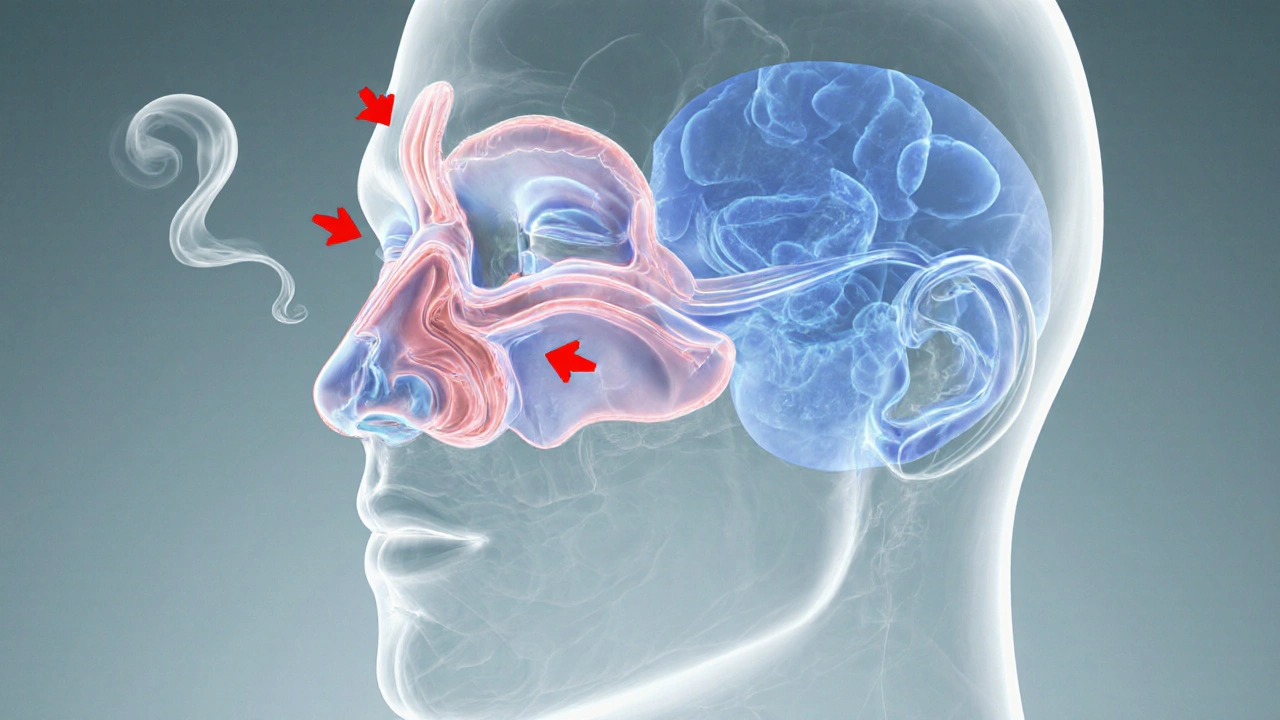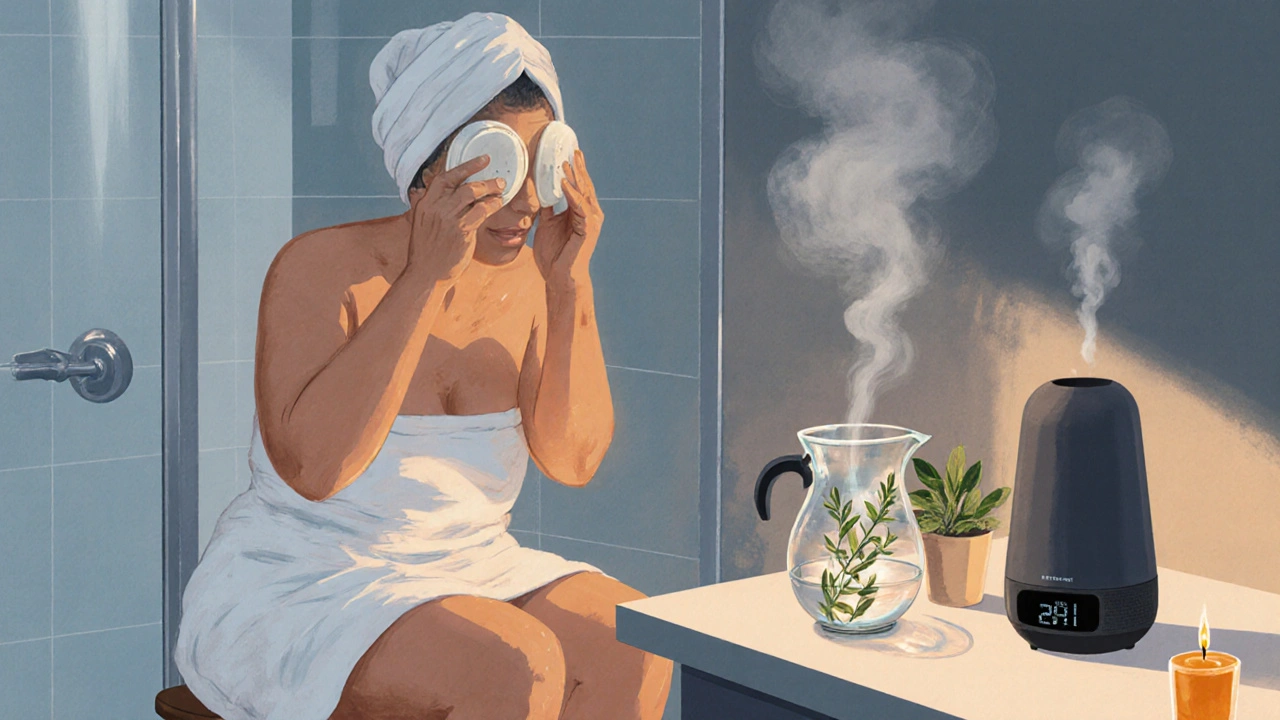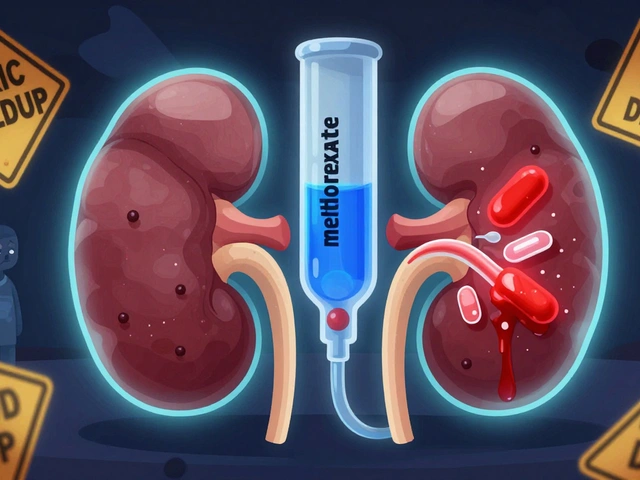
Runny Nose vs Sinus Headache Checker
Take this quick 5-question quiz to identify your symptoms
Answer truthfully based on your current symptoms to get a personalized analysis.
Your Results
Ever wonder why a simple drip from your nose sometimes feels like a pounding in your head? Most people mix up a runny nose with a sinus headache - but they’re not the same thing. Knowing the difference can save you time, money, and a lot of unnecessary worry.
Key Takeaways
- A runny nose is usually a symptom of irritation or infection in the nasal passages.
- A sinus headache originates from pressure or inflammation inside the sinuses, not just excess mucus.
- Location, pain quality, and accompanying signs (like facial tenderness) help you tell them apart.
- Mild cases often improve with home care; persistent or severe pain needs a doctor’s eye.
- Preventing allergies and keeping sinuses moist reduces both problems.
What Exactly Is a Runny Nose?
When you think of a runny nose, picture the clear, watery discharge that drips from the nostrils. Medically, this symptom is called rhinorrhea. It’s the body’s way of flushing out irritants, germs, or excess mucus.
Common triggers include:
- Seasonal or year‑round allergic rhinitis (pollen, dust mites, pet dander).
- The common cold, which inflames the lining of the nasal passage.
- Changes in temperature, spicy foods, or strong odors.
Most of the time, a runny nose is harmless and clears up within a week.
What Is a Sinus Headache?
Sinus headache describes pain that comes from inflamed or blocked sinuses - the air‑filled cavities behind your forehead, cheeks, and nose. When these spaces fill with thick mucus or swell, pressure builds and you feel a deep, steady ache.
Key signs include:
- Pain centered over the forehead, cheeks, or bridge of the nose.
- Worsening pain when you tilt your head forward or lie down.
- Facial tenderness, especially when you press on the cheekbones.
- Possible fever, dark nasal discharge, or post‑nasal drip.
Unlike a migraine, the pain is usually constant and matches the location of the affected sinus.

How to Tell Them Apart
Both conditions can happen at the same time, but a few clues make it easier to differentiate:
| Feature | Runny Nose | Sinus Headache |
|---|---|---|
| Primary symptom | Excess clear or colored mucus | Pulsating or pressure‑type pain |
| Pain location | Rare; usually just irritation | Forehead, cheeks, bridge of nose |
| Trigger | Allergens, infections, irritants | Blocked sinuses from infection or allergy |
| Worsens with | Cold air, smelling strong scents | Head forward, lying flat, sudden temperature change |
| Accompanying signs | Sneezing, itchy eyes | Facial tenderness, fever, thick yellow/green discharge |
If you mainly have a drip with occasional sneezing, you’re likely dealing with a runny nose. If pressure builds and you feel a dull ache that follows the sinuses’ outline, think sinus headache.
Common Causes Behind Both Issues
Understanding the root helps you treat the right problem.
- Allergies: Pollen, mould, pet dander can cause both rhinitis (runny nose) and sinus inflammation.
- Viral infections: The common cold often starts with a runny nose and can progress to sinusitis, leading to a sinus headache.
- Environmental factors: Dry indoor heating in winter dries nasal passages, encouraging mucus buildup and sinus pressure.
- Structural issues: Deviated septum or nasal polyps block drainage, making mucus linger and increasing sinus pressure.
When to See a Doctor
Most cases clear up with home care, but watch for red flags.
- Symptoms last longer than 10 days without improvement.
- Severe facial pain that wakes you up at night.
- High fever (above 38.5°C / 101.3°F).
- Vision changes, swollen eyes, or a stiff neck.
- Recurrent sinus headaches after each cold.
Your GP may order a CT scan or a nasal endoscopy to check for chronic sinusitis.

Quick Relief Options
Try these simple steps before booking an appointment.
- Stay hydrated - water thins mucus and eases drainage.
- Use a saline nasal spray or neti pot (sterile water) to flush out irritants.
- Apply a warm compress over the forehead and cheeks for 10‑15 minutes; the heat loosens blocked sinuses. \n
- Take an over‑the‑counter decongestant (pseudoephedrine) for short‑term relief, but avoid it if you have high blood pressure.
- For pain, an analgesic like ibuprofen reduces inflammation and eases pressure.
If allergies are the culprit, an antihistamine can cut both the runny nose and sinus swelling.
Prevention Tips to Keep Both at Bay
- Keep indoor humidity around 40‑50% using a humidifier during winter.
- Wash bedding weekly in hot water to reduce dust mites.
- Take a daily low‑dose antihistamine during peak pollen seasons.
- Avoid smoking and second‑hand smoke, which irritates nasal lining.
- Practice good hand hygiene to limit viral colds.
Consistent care of your nasal passages and sinuses means fewer drips and fewer thumping headaches.
Comparison at a Glance
| Aspect | Runny Nose | Sinus Headache |
|---|---|---|
| Primary cause | Irritation or infection of nasal lining | Inflamed/blocked sinuses causing pressure |
| Main symptom | Excess mucus, sneezing | Steady facial pain, pressure |
| Pain location | Rare, mild throat irritation | Forehead, cheeks, bridge of nose |
| Duration | Usually 3‑7 days | Often 5‑10 days if untreated |
| Typical treatment | Saline rinse, antihistamines | Decongestants, NSAIDs, sometimes antibiotics |
| When to seek care | Fever >38°C, lasts >10 days | Severe pain, fever, vision changes |
Frequently Asked Questions
Can a runny nose cause a sinus headache?
Yes. When mucus backs up into the sinuses, it can create pressure that turns into a headache. Treating the drip early often prevents the pain.
How do I know if my headache is a sinus headache or a migraine?
Migraine pain is usually throbbing, one‑sided, and worsens with light or sound. Sinus pain is constant, felt over the forehead or cheeks, and intensifies when you bend forward.
Are antibiotics needed for a sinus headache?
Only if a bacterial infection is confirmed. Most sinus headaches stem from viral colds or allergies, which don’t respond to antibiotics.
What home remedies work best for sinus pressure?
Steam inhalation, warm compresses, saline rinses, and staying hydrated are the top DIY tools. Adding a pinch of eucalyptus oil to the steam can boost relief.
When should I use a decongestant?
If nasal congestion is making it hard to breathe or worsening sinus pressure, a short course (no more than 3 days) of an oral decongestant can help. Avoid long‑term use to prevent rebound congestion.
Understanding the subtle clues between a runny nose and a sinus headache empowers you to choose the right remedy and avoid unnecessary doctor visits. Keep an eye on the symptoms, apply simple home care, and know when professional help is the safest move.






10 Comments
Sounds like you've pulled together a solid checklist for anyone stuck between a drip and a pounding head. The clear division between discharge type and facial pressure is spot on. I’d add that staying hydrated early on can actually thin the mucus and reduce that forward‑bending pain. Also, keeping a humidifier running at night helps keep the nasal lining from drying out. All in all, a practical quick‑fix guide.
Nice rundown, definitely a handy reference for the next cold.
If you ignore the bending‑forward cue, you’ll just amplify the sinus pressure.
Wow, this TL;DR feels like a mini‑clinic in my feed. The way you separate “clear runny nose” from “thick sinus pressure” makes the difference crystal clear. I love the tip about warm compresses – they’re like a spa day for your forehead. Saline sprays are cheap, but they actually work better than many pricey meds. Also, the reminder to watch out for fever >38.5°C is a lifesaver. Thanks for making the science feel friendly and fun.
While the practical advice is solid, I must point out a minor inaccuracy: the term “rhinorrhea” refers specifically to nasal discharge, not to the broader category of “runny nose”. Additionally, “decongestants” should be qualified as “nasal decongestants” to avoid confusion with systemic agents. The distinction between viral and bacterial sinusitis also warrants emphasis, as antibiotics are only justified in the latter case. Lastly, the recommendation to avoid decongestants in hypertension patients is crucial, yet the dosage limits were omitted. Overall, the guide is useful, but precision matters.
Ths article was very helpfull. I liked the part about using a neti pot but itt can be a bit messy if not done right. Also the bit about steam inhalation was great, just make sure the water isn't too hot. I think the table comparrison could be bigger though. Thanks for the info!
Great stuff! 👍 The quick quiz is a fun way to self‑diagnose before calling the doctor. I love the reminder to keep a humidifier humming in winter – it’s a game changer. Saline nasal spray + warm compress = instant relief. Keep the tips coming! 🙌
Totally agree, the combo of steam and hydration works wonders for me during allergy season. I also keep a small bottle of eye drops handy for the itchy eyes that come with a runny nose. It’s amazing how a few simple steps can prevent a full‑blown sinus headache.
Oh sure, because we all have a spare 5‑minute slot every morning to do a full sinus spa routine. If I wanted a drama, I’d watch a soap opera, not rinse my nose.
The distinction between viral and bacterial causes is often overlooked, leading to unnecessary antibiotic prescriptions.